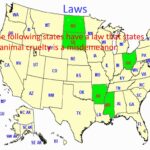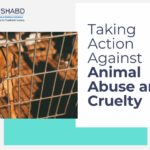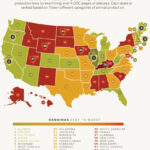Animal cruelty is a pervasive issue that transcends local jurisdictions, prompting discussions on when such acts elevate to a federal offense. Understanding this distinction is vital for animal advocates, legislators, and the general public alike. As we delve into this subject, it’s crucial to elucidate the various dimensions of animal cruelty laws in the United States while addressing the pervasive fascination with these issues and the underlying rationale behind them.
In the U.S., animal cruelty encompasses a variety of behaviors, including neglect, physical abuse, and even exploitation for financial gain. The complexity of this topic originates from the fragmented nature of legal definitions and enforcement mechanisms. Most states possess their own statutes, but the question arises: when does animal cruelty become a federal matter? In this discussion, we will examine scenarios where state and federal jurisdictions collide, the relevant legislation at the federal level, and the societal implications surrounding these laws.
At its core, federal animal cruelty laws exist to address crimes that have implications beyond state lines. For example, the Animal Welfare Act (AWA) is the principal federal legislation that governs the treatment of animals, specifically those involved in research, exhibited in zoos, or transported across state lines. The AWA mandates humane treatment standards and emphasizes the need for minimal stress, pain, and suffering. However, the Act does exclude certain groups, such as farm animals, largely leaving their treatment regulated by state law.
When animal cruelty cases transcend state lines — for example, through interstate transport of abused animals or the involvement of organized animal fighting rings — federal law can intervene. The Animal Fighting Venture Prohibition Act is another significant piece of legislation pertinent to this issue. This act prohibits engaging in, promoting, or hosting animal fights, which are considered felonies under federal law. This intersection of animal welfare and organized crime underscores the intricacies involved in prosecuting animal cruelty as a federal offense.
Compounding the complexity is the federal government’s tendency to act in concert with state laws, often leading to a patchwork of protections. While most animal cruelty cases are prosecuted at the state level, certain egregious acts may warrant federal consideration, particularly when an animal cruelty act reveals broader systemic issues, such as human trafficking or drug-related violence. Such cases are not just about the animals involved; they signify deeper societal maladies and complexities that require comprehensive approaches in addressing them.
Moreover, the fascination surrounding animal cruelty laws often stems from the profound emotional responses elicited by cases of abuse. Society increasingly recognizes animals as sentient beings deserving of protection. High-profile cases of severe animal abuse have catalyzed public outcry and legislative action. For instance, notable cases involving dog fighting or the maltreatment of animals in the agricultural industry have inspired grassroots movements advocating for stronger protections and harsher penalties. It provokes an inevitable curiosity – why do we react so intensely to the suffering of animals? Is it merely empathy, or does it tap into a broader narrative of moral responsibility?
Underlying this emotional investment is a psychological component that intertwines our views on animal welfare with cultural norms. The human-animal bond is a potent force; it drives companies to adopt humane practices and pressures politicians to advocate for animal welfare laws. This cultural shift towards viewing animals as companions rather than property reflects an evolving consciousness, wherein animal welfare becomes a public concern rather than a private issue. Consequently, the discourse surrounding when animal cruelty becomes a federal offense intersects with broader sociocultural dynamics.
Policy-makers must grapple with the consequences of such emotional investment. The challenges of enforcing animal welfare laws against a backdrop of varying ethical perspectives rendered across diverse communities cannot be overstated. The very act of defining animal cruelty, understanding its contexts, and legislating effectively involves a delicate balance of moral viewpoints, reflecting societal values across the nation.
In addition to existing legislation, emerging challenges complicate the landscape of animal cruelty laws. New technologies and methods for animal exploitation, such as puppy mills and internet platforms for illegal animal sales, require vigilant adaptation and enforcement of laws. This evolving landscape calls for more rigorous law enforcement efforts, public awareness campaigns, and collaboration between state and federal authorities to monitor and address emerging threats to animal welfare.
In summary, federal animal cruelty laws serve as a crucial component in the broader conversation surrounding animal welfare. Situations of animal cruelty that cross state lines or involve federal crimes necessitate unique legal frameworks to ensure appropriate responses. The emotional ties and societal implications surrounding animal cruelty bolster the importance of this area of law, urging ongoing discourse, advocacy, and legislative reform. As our understanding of animal rights deepens, so too must our commitment to combating cruelty in all its forms, ultimately fostering a future where animals are treated with the dignity and respect they inherently deserve.







